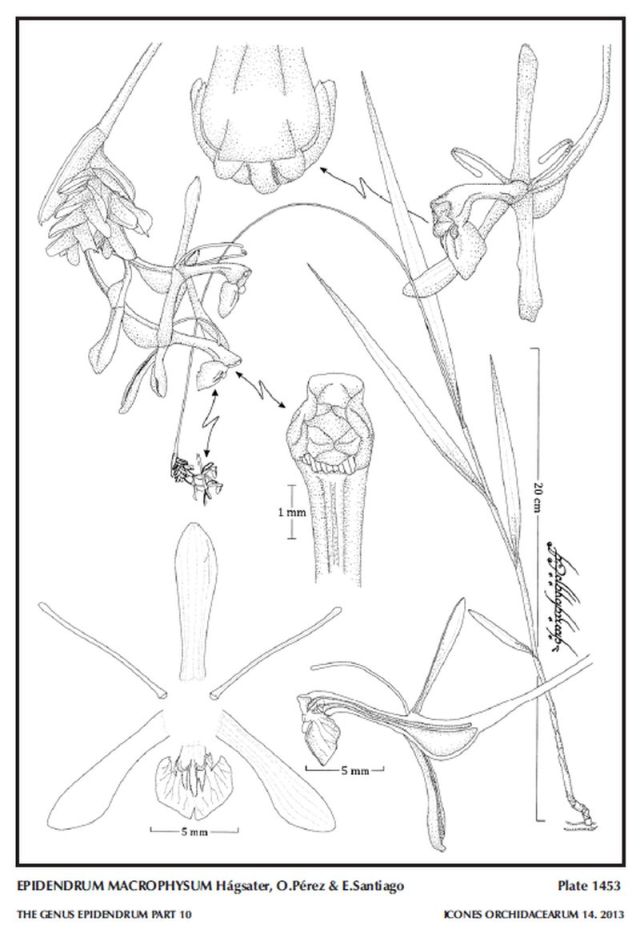

Epidendrum macrophysum Hágsater, O.Pérez & E.Santiago 2013 GROUP Alberti SUBGROUP Allenii
TYPE Drawing by © O Perez and The AMO Herbaria Website



Common Name The Large Bladder Epidendrum [refers to the very large inflated vesicle on the ventral, apical side of the ovary]
Flower Size .8” [2 cm]
Found in Choco department of Colombia on the western slope of the Cordillera Occidental in cloud forests at elevations around 1400 to 1500 meters as medium sized, cool growing epiphyte with cane-like, simple, straight, thin, basal half terete, ancipitose towards the apex stems carrying 4 to 5, all along the apical half of the stem, basally smaller, linear-lanceolate, long-acuminate, central veined as well as 2 evident secondary veins on the upper side, margin entire leaves that blooms in the fall on a terminal, arising through a single, at the apex of the peduncle, narrowly elliptic, obtuse, conduplicate, ancipitous spathe, pluriracemse, arching-pendant, with up to 4 racemes forming from within the apex, peduncle filiform, to 7.8” [19 cm] long, ancipitous, two winged, thin, rachis to .4” [1 cm] long, short, hidden within the floral bracts, densely, successively single, few flowered inflorescence with shorter than the ovary, basally sub oblong, apically elliptic, rounded and apiculate, conduplicate, dorsally carinate, distichous, imbricate at the base, persistent, pale green with irregular lilac spoted floral bracts and carrying resupinate, pale green flowers with the apex of the column greenish white as well as the callus and disc being greenish white.
"Epidendrum macrophysum belongs to the GROUP Alberti which is characterized by the sympodial habit, laterally compressed to ancipitose or somewhat fusiform-thickened stems, the apical or apical and lateral racemose, distichous inflorescence more or less with imbricating bracts on the peduncle, producing one flower at a time, and the SUBGROUP Allenii which is characterized by the stems with numerous leaves, the inflorescence apical (rarely lateral), peduncle elongated, bare, non-bract bearing, two-winged, the rachis short, covered by rounded, usually imbricating bracts. The species is recognized by the almost filiform and long peduncle of the inflorescence, which is almost as long as the stem, the sub-oblong to elliptical, rounded floral bracts .16 to .184" [4 to 4.6 mm] long, which somehow are a reminiscent of the glumes' flowers of some Fimbristylis species (Cyperaceae) and other sedges, the ventricose, prominent vesicle of the ovary and by the sub-orbicular to cordiform lip with a disc with three sub-equal ribs, .156 x .18" [3.9 x 4.5 mm]. It is similar to E. jefeallenii Hágsater & García-Cruz from Panama, which has more ancipitose peduncles, two-winged, the wings prominent; the inflorescence with larger racemes with 5 to 10 successive flowers; ovary slightly inflated in the apical third and a cordiform lip with emarginate apex, .16 to .2" x .2 to .24" [4 to 5 x 5 to 6 mm], with a single rib spreading from the base to the half of the lip. It is also similar to Epidendrum adnatum Ames & C.Schweinf., from Costa Rica and Panama, which has shorter inflorescences with ancipitose peduncles, two-winged, the wings prominent towards the base; an ovary dilated just behind the perianth; oblanceloate, sub-acute, mucronate, sepals; and a ovate, sub-acute, apiculate lip with the margin slightly erose." Hagsater etal 2013
Synonyms
References W3 Tropicos, Kew Monocot list , IPNI ; * Icones Orchidacearum 14 Plate 1453 Hagsater O Perez & Santiago 2013 drawing fide; Orchids of the Department of Valle de Cauca Colombia Vol 2 Kolanowska, Hagsater, Ayala and Saldana 2014 drawing fide; Icones Orchidacearum 16[1] Plate 1665 Hagsater & Sanchez 2018 see recognition section;
--------------------------------------------------------------------------------------------------------------------------
--------------------------------------------------------------------------------